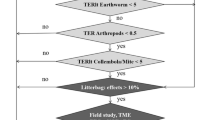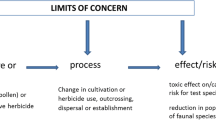Abstract
The EU Plant Protection Product Directive 91/414/EEC recommends the EPPO/CoE Arthropod Natural Enemies Risk Assessment Scheme for guidance on how to conduct risk assessments for terrestrial non-target arthropods. This scheme is currently in the process of being revised by EPPO/ CoE. A major change will be the recommendation for the generation and use of ’Dose Response’ toxicity data instead of limit test data. In addition, the revised EPPO/CoE Non-target Arthropods Risk Assessment Scheme will replace the current arbitrary 30% threshold trigger value applied to limit test data, with a Hazard Quotient (HQ; = Ratio Application Rate/LC50 on Glass)), comparable to the successful approach adopted in the EPPO/CoE ’Honeybee Risk Assessment Scheme’. However, in order for this new approach to be implemented under 91/414/EEC, an appropriate regulatory HQ trigger value needs to be derived. Such an HQ trigger value has been established by calculating HQ values for the 2 recommended sensitive indicator species (T pyri andAphidius) for a wide range of products and validating opposite robust semi-field/field data. This validation indicated that an HQ trigger value of ≥ 12 forT pyri and ≥ 8 forAphidius spp., should be used to trigger higher-tier risk assessment and/or higher-tier testing for non-target arthropods. As these trigger values were validated with realistic semi-field/ field data they apply for both lethal and sub-lethal effects as well as single and multiple application scenarios. Due to the worst case assumptions used in this HQ validation analysis, no further uncertainty factors need to be applied for in-crop risk assessment. Whilst a small amount of uncertainty exists regarding the comparative sensitivity ofT pyri andAphidius spp. for off-crop non-target arthropod guilds of arthropods, this is balanced by the fact that the off-crop exposure assessment used in the HQ derivation, is at least an order of magnitude higher than that realistically likely in the field. This HQ approach and trigger value is an appropriate and conservative tool for tier 1 risk assessment, which should reduce the number of false positive results leading to unnecessary higher-tier testing.
Similar content being viewed by others
References
Aldridge, C. A.;Hart, A. D. M., 1993: Validation of the EPPO/CoE risk assessment scheme for honeybees. In: Proceedings of the Fifth International Symposium on the Hazards of Pesticides to Bees, October 26–28, 1993 Plant Prot. Service, Wageningen, 37–41.
Bakker, F., 1998: Accuracy and efficiency of sequential pesticide testing protocols for phytoseiid mites. In: Ecotoxicology, Pesticides and Beneficial Organisms (P. T. Haskell & P. McEwen, (eds.), Kluwer, Dordrecht, 148–165.
Bakker, F.,Grove, A.;Blümel, S.;Calis, J.;Oomen, P., 1992: Side-effect tests for phytoseiids and their rearing methods. Bull. IOBC/WPRS 1992/XV/3, 61–82.
Barrett, K. L., Grandy, N.;Harrison, E. G.;Hassan, S.;Oomen, P. (eds.), 1994: Guidance Document on Regulatory Testing Procedures for Pesticides with Non-Target Arthropods. SETAC Europe, Brussels.
Bates, D. M.;Watts, D. G., 1988: Nonlinear Regression Analysis and its Applications, Wiley, New York, USA.
Bennett, B. M., 1952: Estimation of the LD50 by moving averages. J. of Hygiene50, 157–164.
Blumel, S.;Baier, B.;Bakker, F.;Bienert, U.;Candolfi, M.;Hennig-Gizewski, S.;Kühner, C.;Jäckel, B.;Louis, F.;Ufer, A.;Waltersdorfer, A., 1998: Current status of a ring-tested method to determine pesticide effects on the predatory miteTyphlodromus pyri (Scheuten) (Acarina: Phyto-seiidae) in the laboratory. In: Ecotoxicology, Pesticides and Beneficial Organisms (P. T. Haskell &P. McEwen, eds.), Kluwer, Dordrecht, 89–97.
Blumel, S.;Aldershof, S.;Bakker, F.;Baier, B.;Boller, E.;Brown, K.;Candolfi, M.;Huber, B.;Louis, F.;Linder, C.;Müther, J.;Nienstedt, K.;Oberwalder, C.;Reber, B.;Schirra, K. J.;Ufer, A.;Vogt, H., 2000: Guidance Document to Detect Side Effects of Plant Protection Products on Predatory Mites (Acari: Phytoseiidae) under field conditions: Vineyards and orchards. Predatory Mite Working Group, 2000.
Candolfi M., Bakker, F.;Cañez, V.;Miles, M.;Neumann, C.;Pilling, E.;Priminani, M.;Romijn, K.;Schmuck, R.;Storck-Weyhermüller, S.;Ufer, A.;Waltersdorfer, A., 1999: Sensitivity of non-target arthropods to plant protection products: couldTyphlodromus pyri and Aphidius spp. be used as indicator species? Chemosphere39, 1357–1370.
Council of the European Union, 1991: Council Directive 15 July 1991 concerning the placing of plant protection products on the market (91/414/EEC). Official Journal of the European Communities L230, 1–32.
Council of the European Union, 1996: Commission Directive 96/12/EC of 8 March 1996 amending Council Directive 91/ 414/EEC concerning the placing of plant protection products on the market. Official Journal of the European Communities L65, 20–37.
EPPO/CoE, 1993: Decision making scheme for the environmental risk assessment for plant protection products — Honeybees, EPPO Bulletin23, 151–165.
EPPO/CoE, 1994: Decision making scheme for the environmental risk assessment for plant protection products — Arthropod natural enemies, EPPO Bulletin24, 17–35.
Finney, D. J., 1971: Probit Analysis. 3rd edition, London, Cambridge University Press.
Ganzelmeier, H.;Rautmann, D.;Spangenberg, R.;Stre-loke, M.;Herrmann, M.;Wenzelburger, H.-J.;Walter, H.-F., 1995: Studies on the spray drift of plant protection products. Mitteilungen aus der Biologischen Bundesanstalt fur Land- und Forstwirtschaft305, 111 pp.
Gonzalez-Valero, J. F.;Campbell, P. J.;Fritsch, H.;Grau, R.;Romijn, K., 2000: Exposure assessment for terrestrial non-target arthropods. Submitted to Journal of Pest Science.
Harris, E. K., 1959: Confidence limits for the LD50 using the moving average-angle method. Biometrics,15, 424–432.
Henderson, C. F.;Tilton, E. W., 1955: Tests with acaricides against brown wheat mite. J. Econ. Ent.48, 157–161.
Louis, F.;Ufer, A., 1995: Methodical improvements of standard laboratory tests for determining the side-effects of agro-chemicals on predatory mites (Acari: Phytoseiidae). Anzeiger für Schädlingskunde, Pflanzenschutz und Umweltschutz68, 153–154.
Koch, H.;Weisser, P., 2000: Spray deposits of plant protection products on plants - potential exposure for non target arthropods. Submitted to Chemosphere.
Mead-Briggs, M. A., 1992: A laboratory method for evaluating the side-effects of pesticides on the cereal aphid parasitoidAphidius rhopalosiphi (DeStefani-Perez). Aspects of Applied Biology31, 179–189.
Mead-Briggs M.;Brown, K.;Candolfi, M.;Coulson, M.;Klepka, S.;Kuhner, Ch.;Longley, M.;Maise, S.;Mcin-doe, E.;Miles, M.;Neumann, Ch.;Ufer, A., 1998: Development and ring-testing of a standardised laboratory test for parasitic wasps, using the aphid-specific parasitoidAphidius rhopalosiphi. In: Ecotoxicology, Pesticides and Beneficial Organisms (P. T. Haskell &P. McEwen, eds.), Kluwer, Dordrecht, 80–88.
Oomen, P. A., 1998: Risk Assessment and risk management of pesticide effects on non-target arthropods in Europe. In: The Proceedings of the 1998 BCPC Brighton Conference, Pest & Diseases, 2, 591–598.
Oomen, P. A.;Forster, R.;Lewis, G. P., 1998: Environmental risk assessment for terrestrial non-target arthropods: towards a new EPPO/Council or Europe scheme. Proceedings International 50th Symposium on Crop Protection, Gent, Belgium, 7pp.
Schmuck R.;Mager, H.;Künast, Ch.;Bock, K. D.;Storck-Weyhermüller, S., 1996: Variability in the reproductive performance of beneficial insects in standard laboratory toxicity assays — Implications tor hazard classification of pesticides. Ann. Appl. Biol.128, 437–451.
Shires, S. W., 1998: Pesticides and beneficial arthropods: an industry perspective. In: Ecotoxicology, Pesticides and Beneficial Organisms (P. T. Haskell &P. McEwen, eds.), Kluwer, Dordrecht, 242–247.
Vogt, H.;Degrande, P.;Just, J.;Klepka, S.;Kuhner, Ch.;Nickless, A.;Ueer, A.;Waldburger, M.;Waltersdorfer, A.;Bigler, F., 1998: Side-effects of pesticides on larvae ofChrysoperla earned (Neuroptera, Chrysopidae): actual state of the laboratory method. In: Ecotoxicology, Pesticides and Beneficial Organisms (P. T. Haskell &P. McEwen, eds.), Kluwer, Dordrecht, 123–136.
Author information
Authors and Affiliations
Corresponding author
Rights and permissions
About this article
Cite this article
Campbell, P.J., Brown, K.C., Harrison, E.G. et al. A hazard quotient approach for assessing the risk to non-target arthropods from. J. Pest Science 73, 117–124 (2000). https://doi.org/10.1007/BF02956443
Issue Date:
DOI: https://doi.org/10.1007/BF02956443




